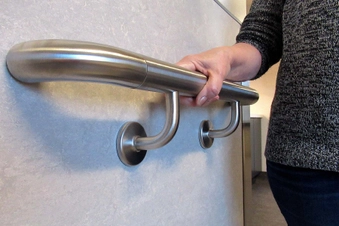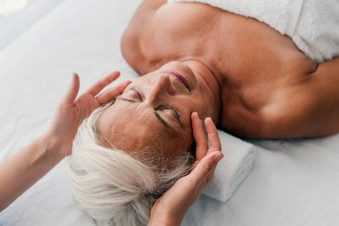Self-Care With Polymyalgia Rheumatica

Learn All You Can About PMR
There are a lot of unknowns about polymyalgia rheumatica, or PMR. It can help to understand what we do know about it. There are no outward signs, so if you can explain it to your loved ones, they’ll have a better idea what’s going on and how to support you. You should also know the signs of giant cell arteritis, another inflammatory condition that’s common in people with PMR.

Take Stock of Your Diet
Protect your health and lower your risk of other conditions with a well-balanced diet. Focus on the core foods of the Mediterranean diet, like whole grains and fruits and vegetables. Healthy fats come from foods such as extra-virgin olive oil and fatty fish. These offer nutrients that fight inflammation, like omega-3 fatty acids, fiber, and polyphenols.

Avoid Processed Foods
Steroids, the main medication for PMR, is linked to an increased risk of type 2 diabetes. To lower your risk, skip or cut back on processed foods, which encourage inflammation. These include foods high in refined flour or added sugars like white bread, pasta, and white rice. Also on this list are red and processed meats, deep-fried foods, and sugar-sweetened drinks.

Top Off Your Calcium and D Reserves
Steroids also put you at risk of bone loss because they get in the way of calcium absorption. Choose calcium-rich dairy and dark leafy greens. Get some sun exposure for vitamin D, which works hand-in-glove with calcium. When on long-term steroids (2.5 milligrams or more daily for more than 3 months), take daily supplements. Aim for at least 1,200 milligrams of calcium and 800-1,000 international units (IUs) of vitamin D. Ask your doctor for personal guidelines.

Follow a Personal Exercise Plan
A fitness program tailored to your abilities will help you keep moving easily. It will also lessen your chances of falling. Exercise can ease pain and stiffness while it strengthens muscle and bone. It even boosts your mood. Good choices are weight-bearing exercises like walking and strength training. Also good are low-impact swimming and stationary biking. But remember: Don’t overdo things to avoid feeling stiff the next day.

Double Up on R&R
Balance exercise with rest: It gives your body time to recover and prepares you for your next workout. Pace yourself throughout the day and take naps as needed. Rest also means getting quality sleep. If pain keeps you awake, try relaxation techniques like deep breathing, meditation, and guided imagery where you picture yourself in a relaxing place.

Schedule a Physical Therapy Session
A physical therapist is a great person add to your care team. They can design an exercise routine to meet your wellness goals. They’ll also show you specific moves and stretches to ease pain and help you regain strength if you haven’t exercised in a while. Some of the other soothing options in their toolbox include hot and cold therapy and massage.

Use Tools That Make Life Easier
Pain and stiffness in your shoulders and hips can make it harder to do everyday activities, like reaching for things, standing in the shower, or just standing up. Assistive devices like a cane, grab bars, or a shower bench can be a big help. Also, look for ways to save your energy. For instance, you can use a small cart to move essentials from room to room instead of carrying them.

Keep a Symptoms Log
A diary can help you spot changes that could be caused by steroids, like weight gain, trouble sleeping, and changes to your skin. Ask your doctor what signs to report right away as well as what to expect when you taper off of steroids.

Get the Most From Time With Your Doctor
Keep all your appointments: These are your doctor’s chance to spot steroid side effects that you can’t see, like bone density loss, high blood pressure, diabetes, and cataracts. They’re also your chance to share your symptoms log, talk about how you’re responding to treatment, and ask questions.

Be Careful With OTC Pain Medication
Steroids alone may not be enough to control your pain. But over-the-counter NSAIDs like ibuprofen or naproxen aren’t usually used to treat PMR. So ask your doctor before you try any over-the-counter painkillers. You may be able to use them under their guidance when you start to taper off steroids. Until then, if you need more ways to manage pain, try heat for muscle aches, cold for inflammation, and gentle exercise for stiffness.

Consider Massage
There’s a shortage of research on PMR treatments other than steroids. But complementary and alternative, or CAM, options may help. A survey of people who tried them found that the most popular nondrug therapy is massage. In fact, 86% of people who got massages said it helped them. Always work with a licensed therapist and clearly let them know where you have discomfort to get the most benefit.

Get Emotional and Practical Support
Living with polymyalgia rheumatica and possibly giant cell arteritis can challenge you at times. Connect with others who know what you’re going through and can lift your spirits. You’ll get ideas to better manage the waves of emotions that you’re likely to have. Ask your medical team if they know of any local support groups or do an online search for support groups for people with PMR.

Don’t Forget Your Mental Health
Sometimes it takes a mental health therapist to help you handle the emotions that come with a disease that has an uncertain course. You have a lot on your plate, from managing pain and taking daily medication to going to medical appointments. All this can lead to feeling overwhelmed, anxious, or depressed. A therapist can give you the space to express what you feel and ways to regain a sense of control.

Steer Clear of Smoke
Smoking cigarettes is bad for your health in general. But it can also worsen your PMR symptoms and make the condition harder to treat. Smoking also ups your risk of osteoporosis when you’re on steroids. If you haven’t been able to quit, ask your medical team for new ideas. Even if you don’t smoke, avoid secondhand smoke.
Show Sources
IMAGES PROVIDED BY:
1) DigitalVision/Getty Images
2) Moment/Getty Images
3) E+/Getty Images
4) E+/Getty Images
5) Moment/Getty Images
6) E+/Getty Images
7) iStock/Getty Images
8) iStock/Getty Images
9) Moment/Getty Images
10) DigitalVision/Getty Images
11) E+/Getty Images
12) E+/Getty Images
13) E+/Getty Images
14) Westend61/Getty Images
15) Moment/Getty Images
SOURCES:
Polymyalgia Rheumatica & Giant Cell Arteritis UK: “Living with PMR/GCA,” “Exercise and Nutrition.”
Mayo Clinic: “Polymyalgia Rheumatica.”
Better Health Channel (Australia): “Polymyalgia Rheumatica.”
Johns Hopkins: “Anti-inflammatory Diet.”
Cleveland Clinic Journal of Medicine: “Polymyalgia Rheumatica: An Updated Review.”
American College of Rheumatology: “Glucocorticoid-Induced Osteoporosis.”
Rheumatology Advances in Practice: “Treatment of Polymyalgia Rheumatica: British Society for Rheumatology Guideline Scope.”
Cleveland Clinic: “Polymyalgia Rheumatica.”
MyHealth Alberta (Canada): “Polymyalgia Rheumatica: Care Instructions.”
National Institute of Arthritis and Musculoskeletal and Skin Diseases: “Polymyalgia Rheumatica and Giant Cell Arteritis Basics: Diagnosis, Treatment, and Steps to Take.”
Arthritis Foundation: “Polymyalgia Rheumatica.”
Harvard Health: “How to Sleep Well Despite Chronic Pain,” “Therapeutic Massage for Pain Relief.”
Wellstar: “Polymyalgia Rheumatica.”
Dove Press: Research and Reviews: “A qualitative study of patient perspectives related to glucocorticoid therapy in polymyalgia rheumatica and giant cell arteritis.”
Medscape: “Polymyalgia Rheumatica (PMR) Medication.”
Rheumatology International: “What non-pharmacological treatments do people with polymyalgia rheumatica try: results from the PMR Cohort Study.”
American Physical Therapy Private Practice: “Basic Physical Therapy Equipment List.”